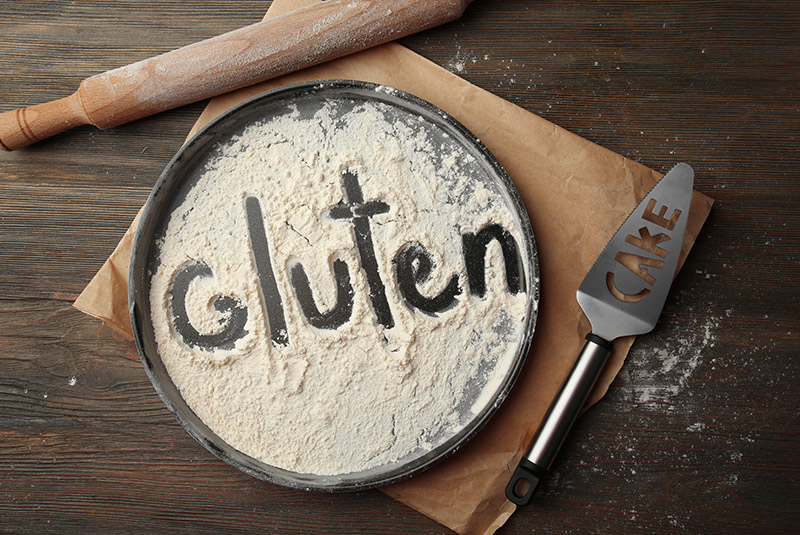New research sheds light on risk of gluten exposure in the kitchen and classroom

Parents and teachers typically go to great lengths in the kitchen and in the classroom to ensure children with Celiac disease avoid gluten contact. But up until recently, little data has existed to quantify the risk that exists in a variety of scenarios. Now, new research suggests that while vigilance is key, people may be able to strategically scale back some of their avoidance efforts — such as using as a separate toaster and foregoing Play-Doh —without putting kids at unnecessary risk.
Concerns about gluten cross contamination
Exposure to gluten is a serious concern for people with Celiac disease, an autoimmune disease in which eating gluten (a protein in rye, barley, and wheat) causes damage to the small intestine.
As a result, many dietary guides recommend that people be stringent when preparing food to avoid gluten contamination. In addition, experts warn that classroom activities like arts and crafts and home economics can put kids with Celiac disease at risk because many common supplies contain gluten. Yet little research has existed to quantify the true risk of cross-contamination in different situations.
Looking for answers about gluten transfer
This fact recently prompted Jocelyn Silvester, MD, PhD, director of research for the Boston Children’s Hospital Celiac Disease Program to team up with colleagues from Children’s National in Washington, DC, to explore cross-contamination in the kitchen.
“This is the first study to examine common practices when gluten-free food is prepared in the same kitchen as gluten-containing food. The data can help guide assessment of the risk of cross-contact so we can advise our patients with Celiac disease,” explains Silvester.
The researchers explored the risk of contamination that occurs in several food preparation processes, including using the same toaster for both gluten and gluten-free foods, to see if gluten content would rise above 0.002 percent gluten (also referred to as 20 ppm). The US Food and Drug Administration (FDA) designates food below this threshold to be officially “gluten-free.”
Measuring gluten transfer in toasters
The study findings, published in Gastroenterology in January 2020, revealed that using the same toaster for both gluten and gluten-free bread may not pose significant risk for people with Celiac disease. To come to this conclusion, the authors toasted 40 gluten-free slices and found that the gluten levels remained below 20 ppm despite having crumbs in the toaster from gluten-containing bread.
Other highlights from this study include:
- People should never eat foods or use utensils with visible contamination from gluten-containing foods.
- Gluten-free food should be cooked first, then set aside before gluten-containing food is handled.
- When eating out, people should always ask the restaurant how gluten-free pasta is cooked and heated to be sure separate water is being used for gluten and gluten-free items.
- Typical dishwashing removes gluten so dedicated gluten-free pots and metal utensils are not needed.
“These findings focus upon the importance of avoiding gluten and limiting risk whenever possible, but not to the extent that gluten avoidance leads to unnecessary anxiety or severely and excessively limits patient and family activities beyond what is necessary,” says Dascha Weir, MD, clinical director of the Celiac Disease Program at Boston Children’s.
Exploring gluten-exposure through school activities
Another study Silvester was involved in recently appeared in the Journal of Pediatric Gastroenterology & Nutrition. “We wanted to measure gluten transfer from school supplies to gluten-free foods that a child with Celiac disease may eat,” she explains. This is the first such study to examine common educational activities in this context.
To get a handle on the risks, the researchers had healthy children without Celiac disease or gluten allergy engage in activities with items containing gluten, including paper mâché, a baking project, cooked pasta, Play-Doh, and dry pasta. Following exposure, slices of gluten-free bread were rubbed on the students’ hands and on the tabletop. Then the researchers measured gluten levels on the bread to assess potential gluten transfer.
While paper mâché, cooked pasta used in sensory tables, and the baking project resulted in rates of gluten transfer on the bread of far greater than the threshold of 20ppm, Play-Doh (which contains wheat) and raw pasta had low gluten transfer. The school study also found that water (or soap and water) was the most effective method for removing gluten.
Using evidence to guide gluten-free choices
Based on the study findings, Silvester and her colleagues at the Celiac Disease Program offer the following recommendations for children with Celiac disease or gluten allergies:
- It’s always best to use gluten-free modeling clays. When that isn’t possible, using a gluten-containing form of clay in a supervised setting with scrupulous cleaning of hands and surfaces to remove all visible contamination is likely safe. (Just keep in mind that some children suck their thumb or put their hands in their mouth, which greatly increases the risk.)
- Gluten-free pasta for art and other classroom projects should be used whenever possible. Dry pasta containing gluten appears to pose a low risk unless there is oral exposure. However, wet pasta can stick to hands and surfaces, increasing the risk.
- Only gluten-free flours, powders, and pastes (such as paper mâché) should be used.
- In all scenarios, careful handwashing, thorough cleaning of the environment, and adult supervision is essential.
Minimizing gluten exposure in schools
“These findings call attention to the need for clear communication with daycare or school regarding celiac disease, including the need for a gluten-free diet and maintenance of a safe environment,” says Janis Arnold, MSW, LICSW, of Boston Children’s Celiac Program. In addition to these conversations, she adds that a formal 504 Plan or Individual Health Plan (IHP) may be helpful for the student with Celiac disease.
Learn about our Celiac Disease Program.
Related Posts :
-

Team spirit: How working with an allergy psychologist got Amber back to cheering
A bubbly high schooler with lots of friends and a passion for competitive cheerleading: On the surface, Amber’s life ...
-

Thanks to Carter and his family, people are talking about spastic paraplegia
Nine-year-old Carter may be the most devoted — and popular — sports fan in his Connecticut town. “He loves all sports,” ...
-

Genetic causes of congenital diarrhea and enteropathy come into focus
Congenital diarrheas and enteropathies are rare and devastating for infants and children. Treatments have consisted mainly of fluid and nutritional ...
-

Genomic sequencing transforms a life: Asa’s story
Asa Cibelli feels like he’s been reborn. The straight-A middle schooler plays basketball and football, does jiu jitsu, is ...





